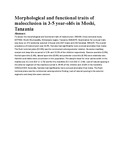| dc.contributor.author | Rwakatema, DS | |
| dc.contributor.author | Ng'ang'a, PM | |
| dc.date.accessioned | 2013-04-30T07:42:53Z | |
| dc.date.available | 2013-04-30T07:42:53Z | |
| dc.date.issued | 2009 | |
| dc.identifier.citation | East Afr Med J. 2009 Oct;86(10):486-90 | en |
| dc.identifier.uri | http://www.ncbi.nlm.nih.gov/pubmed/21650073 | |
| dc.identifier.uri | http://erepository.uonbi.ac.ke:8080/xmlui/handle/123456789/17909 | |
| dc.description.abstract | To assess the morphological and functional traits of malocclusion.
DESIGN:
Cross-sectional study.
SETTING:
Moshi Municipality, Kilimanjaro region, Tanzania.
SUBJECTS:
Examination for occlusal traits was done on 372 randomly selected 3-5-year olds (157 males and 215 females).
RESULTS:
The overall prevalence of malocclusion was 26.9%. Females had significantly more occlusal anomalies than males. The flush terminal plane (93.8%) was the commonest anteroposterior relation. Excessive maxillary overjet and deep-bite occurred in 5.1% and 21.5% of the children respectively. Reverse overbite (1.9%), frontal open-bite (1.6%), lateral open-bite (0.8%) and posterior cross-bite (0.3%) were relatively rare. Harmful oral habits were uncommon in this population. The sample mean for inter canine width in the maxilla was 31.1 mm (SD +/- 2.72) and for the mandible 25.3 mm (SD +/- 2.46). Lack of natural spacing in the anterior segment of the maxilla occurred in 34.4% of the children and 33.6% in the mandible.
CONCLUSION:
Generally, females had significantly more occlusal anomalies than males. The flush terminal plane was the commonest anteroposterior finding. Lack of natural spacing in the anterior segments and deep bite were common. | en |
| dc.language.iso | en | en |
| dc.title | Morphological and functional traits of malocclusion in 3-5 year-olds in Moshi, Tanzania | en |
| dc.type | Article | en |

